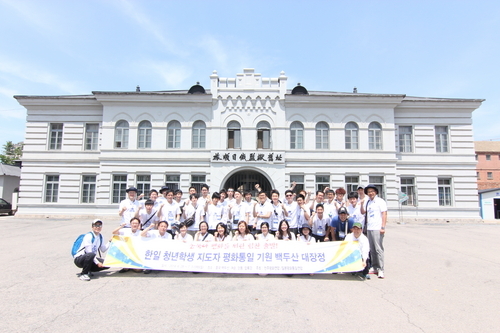
- Home > News > News Articles

| Title | [Weekly Korea] Korean and Japanese Students’ “Kind” Outlook on Colonization and North and South Unification | |||
|---|---|---|---|---|
| Date | 2014-07-12 | Hit | 10450 | |
| File |
|
|||
|
Korean and Japanese Students’ “Kind” Outlook on Colonization and North and South Unification Korean and Japanese students visit historical anti-Japan sites and Baekdusan. Restoration of Joong-Geun Ahn’s Court and Death Penalty Sites “Create a gathering on world peace doctrines and eastern peace theory.”
“We are making an effort to understand the other. First, people must become one.” Korean and Japanese students: “We became closer as we shared our thoughts.” “We wish to contribute to North and South Korea and peace in Northeast Asia.” Korea-Japan relations are becoming more strained every day, but the people recently implemented a meaningful exchange project. The Universal Peace Federation (UPF), Japan Peace and Unification Federation and the Universal Peace Academy (UPA) co-hosted the “Korea-Japan Youth Leaders March for Peace and Unification.” Approximately 31 university students from both Korea and Japan explored China’s historical anti-Japan sites and Baekdusan from June 28th to July 3rd over six days. It was an opportunity to communicate about the past and prepare for the future. Most of the Korean and Japanese students who participated grew up in the religious tradition of the Family Federation for World Peace and Unification (Unification Church). Followers of the Unification church, which emphasizes family and purity, do not drink or smoke. It was also impressive that most of the Japanese students had a command of intermediate–level Korean. A few of these students were born from Korean-Japanese couples who participated in the mass weddings. As second generation members of Korean-Japanese families, they inherited good characteristics from each nation. From Japan, they inherited sensitivity to others. From Korea, they inherited passion and zeal for life. The Unification Church emphasizes marriage as the path to solving conflict and disputes and creating peace. So far, there are ten thousand families, or about fifty thousand people, who have created families this way. We can confidently trust that these young people will contribute to building and nurturing friendship between Korea and Japan. Lushun Prison Reveals the Pain of the War and Colonization The exploration team left Incheon on June 28th and arrived in China’s Dairen Port the next day. Japan overtook Dairen from Russia after it won the Russo-Japanese War. As a formerly occupied city, western-style buildings and modern buildings harmonized in the clean city. The team ate lunch at the former Kwandonggoon military police building, which has been turned into a restaurant, then traveled to the Lushun Prison. Among the buildings stood the site where Patriot Joong-Geun Ahn assassinated Hirobumi Ito and was arrested and questioned. The Chinese government allowed Korean and Japanese visitors into the Lushun Prison just five years ago. That was how painful the Japanese Imperialism was to the Chinese. From 1907 until the end of the Japanese rule, numerous independence activists and strike leaders experienced hard labor, beatings and torture. A “large-scale massacre” even occurred near the end of the Chinese-Japanese War, following the impeding Russian Army advancement. Lushun Prison is especially known as the place where Joong-Geun Ahn, Hwe--Young Lee, and Chae-Ho Shin gave their lives for their country. The team offered flowers and a moment of silence at the site where Patriot Ahn gave his life for his country. Wan-Gyu Lee (20) from Cheong Ju School of Education said, “I felt pride that Koreans were able to achieve what not even the Chinese were able to do,” and, “He was extremely well-respected, even by the prison guards, and received global attention during his court case, as well. I was touched by his concern and sacrifice for his country, even right before his death.” In 1992, the Memorial Yeosoon Foundation for Patriots (with Il-Shik Hong as President) was established. The Foundation actively pushed for the placement of a bronze statue of Patriot Ahn inside the Yushun Prison, as well as a commemorative exhibition and a Korean information placard. Recently, the remains of the Yushun Gwangdong Court was purchased and restored. Patriot Ahn’s theory of eastern peace was, “Let’s bring about world peace,” and is the same as the doctrines of the Unification Church. Patriot Ahn was a forerunner for overcoming nationalism. Tae-Chang Morikawa (21) of Sun Moon University’s Northeast Asia Department said, “It was strange to think that historical figures ended their life here. It moved me because I remember studying about Patriot Ahn in elementary school.” He shared his aspiration, adding, “I want to work in the field of North and South Korean unification.” Morikawa was born to a Korean Father and a Japanese mother and studied aerospace science in Japan. However, he dreamed of assisting the unification of North and South Korea and transferred to Sun Moon University in Korea in his third year. |
| Tag | , , | |||
|---|---|---|---|---|







































































